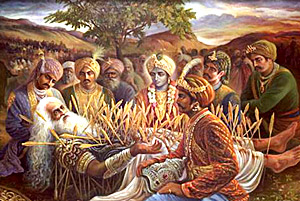
Hindu epic Mahabharata contains 18 books or parvas. The sixth Parva is Bhishma Parva. (sanskrit, पर्वन्, parvan, noun, means portion)
This Bhishma Parva (Main Division) contains the following four Sub Divisions:
Jamvu-khanda Nirmana Parva: 1 to 10 chapters
Bhumi Parva: 11 & 12 chapters
Bhagavat-Gita Parva: 13 to 42 chapters
Bhishma Vadha Parva: 43 to 122 chapters
This book of the Mahabharata is important for two reasons.
First of all, it contains the Bhagavad Gita, the best-known Hindu sacred text.
Secondly, this book describes the start of the enormous battle which is the center-piece of the work, specifically the first ten days of conflict, up to the fate of the hero Bhishma.
The Bhishma Parva starts with an overture of apocalyptic and unnatural portents. It then immediately digresses into a treatise on geography and natural history--one of several texts which the great epic accreted over time.
After this comes the Bhagavad Gita, which unlike some of the other digressions, is a good thematic fit in the narrative. Arjuna, facing a battle in which he will have to fight many of his immediate relatives, is understandably hesitant to fight. The Avatar Krishna then proceeds to explain to Arjuna why he must fulfill his duty as a warrior, and how he can emerge from this spiritual crisis of conscience with a clean slate. This text deals with the contradictions of living a devotional life in an imperfect world. Even non-Hindus have found the Gita meaningful for this reason. Then Krishna reveals to Arjuna his divine form; this section is one of the best attempts to describe the indescribable ever written.
Finally we move on to the battle itself, which occupies two-thirds of Book 6, a relentless and immersive description of the horror of war. This is literally a blow-by-blow description of each incident of combat over a period of ten days. And this is no ordinary battle. The combatants absorb incredible numbers of arrows and are still standing, ready to fight the next day. The field is stalked by vampires and cannibals. There are rivers and oceans of blood and gore. The heroes wield superweapons and magic spells, only described elliptically, with which they slay thousands of opponents at a time. And at the end we learn how Bhishma, the undefeatable leader of Duryodhana's army, is finally brought down.

No comments:
Post a Comment